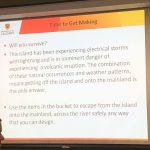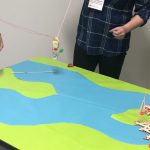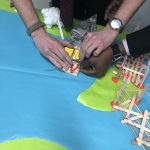
Providing students with opportunities to work together, to set and achieve goals and problem solve through the process can help foster community building. Having students participate in a design challenge (developed by the teacher) is one way to facilitate purposeful, interdisciplinary engagement, in your classroom. As students become more familiar with the design thinking process, they can progress to designing their own challenges.

While obviously not a new concept to educators, the principle of learning-by-doing has been applied in one particular framework, credited to UCLA professor Doreen Nelson, called Design-Based Learning (DBL). Also sometimes called Project- or Problem-Based Learning (PBL), DBL / PBL encourages students to think about how to address a problem in its context, specifically by thinking with the end in mind. As a formal methodology in contemporary education, DBL / PBL gained wider recognition during the 1990s, particularly as the oncoming millennium posed the perceived need for students to learn what popularly became known as 21st century skills.
Design-based learning (and project-based learning) methods encourage experiential learning as a way to overcome student disengagement (Kim, Suh, & Song, 2015; Washor & Mojkowski, 2014), such as increasing the enrolment of women in the field of Information Technology (Jessup & Sumner, 2005). DBL / PBL enables students and their teachers to make use of prior learning to address authentic experiences and so-called real-world problem-solving (Wang, Derry, & Ge, 2017) as compared to the more sheltered lessons and linear hypotheticals of the traditional classroom.

You will find a variety of design challenges freely available online. It is important to consider your own teaching context and learning objectives in selecting or crafting a challenge to meet your/your students and your curricular needs. Design challenges typically offer a well-crafted ‘challenge statement’, design constraints and may include accommodations or may be varied based on the needs/differences in the class.
An Example:
One of my favourite design challenges for upper intermediate, secondary and post-secondary groups is the ‘Newspaper Structures Challenge’:
Materials: large pile of newspaper (broadsheet works better than tabloid style), masking tape, 1-2 m length of dowling or a straw (optional to assist with rolling the newspaper into tubes – starting at a corner of a flattened sheet of newspaper, use the dowel to role a tube, then remove the dowel and tape up the tube)
- The Challenge: Design and build a free standing structure that your whole team can fit inside.
- Design constraints: Use only the available materials, (the dowel is to be used as a tool not a part of the structure); use only a ‘set amount’ of tape; time limit…
- Process: You might provide students with a live demo or video example of how they can create rolled newspaper ‘rods/dowels’ (rolled sheets of paper using a straw or wood dowel) to utilize as building material and have the prep multiple dowels before providing the challenge. Alternatively, you might provide the challenge and have students work together to ‘discover’ the best way for them to use the newspaper to create a structure… (time available and your students resilience, experience problem solving and working as a group are among considerations)
- Variations: the structure may be fastened at certain points to a chair, wall, floor; only X number of people need to fit within the structure; the structure is built to house a stuffy or other object instead of people…
DiscoverE has a PDF resource entitled “Strong Paper Structures” that is an example of an adaptation of the above activity (to make smaller structures and including a bit more leading instructions on designing ‘strong’ structures than I typically provide to older or adult learners if my purpose is community building. If my purpose is more curricular (engineering, science and structures), this project could either be a summative activity or it could be incorporated at the outset of a unit of study as an open-ended way to assess prior knowledge (with little prior instruction provided) and then used as a ‘performance task’ to assess learning at a later point in a unit of study.
This link will take you to a
A key consideration will be the ability of your learners to work together within a group. Regardless of age of learning, the teacher is an important facilitator of learning during this activity (and not simply a by-stander!). Activities like this will provide opportunities to introduce or reinforce and allow students to self-assess their progression in the personal, social and communication ‘Core Competencies’.
A few supportive Resources:
Design a Design Challenge Google Slide Deck:
The slide deck resource below was co-developed with UBC Engineering’s Geering Up program for teacher candidates in the UBC BEd science methodology course. This presentation deck includes the ‘cat in a tree’ design challenge using found objects (lesson plan on their website). It is accompanied by a ‘design your own challenge template’ that teachers/students can use as they plan their own activities. The Geering Up team share many different challenges on their teacher resource site (filter by ‘Challenges’) . They also offer professional development workshops, classroom workshops and will even schedule Zoom consults with teachers wishing to incorporate STEM learning in the classroom.
Another favourite activity:
Cross the river (move from Point A to Point B given different materials or constraints):
- The ‘small’ table top version:
- use a table and paper as a model of land bisected by a water body and provide the challenge: How can you move your lego figure/pom pom/etc from the mainland to the island without touching the water. Provide craft sticks, string, elastic bands, wooden spoons, other materials from around the house/recycling box etc. Consider how you might address environmental impact in your constraints (i.e. amount of material used or that all built structures need to be able to be dismantled and recycled – aka – no glue and limit use of tape)
- use a table and paper as a model of land bisected by a water body and provide the challenge: How can you move your lego figure/pom pom/etc from the mainland to the island without touching the water. Provide craft sticks, string, elastic bands, wooden spoons, other materials from around the house/recycling box etc. Consider how you might address environmental impact in your constraints (i.e. amount of material used or that all built structures need to be able to be dismantled and recycled – aka – no glue and limit use of tape)
- The ‘large body’ PHE version:
- Students, in small groups, each have two matts and are challenged to move from one end of the gym to another. Get from point A to point B without anyone in your group ever touching the floor (the floor is lava!). If any member of the team falls out or touches the ground, the group restarts… they need to replan/strategize/discuss…
- A variation: River Crossing – a popular group activity in PHE classes.
- Exploratorium offers educational resources including design challenges.
- Science World has a repository of free resources including design challenges for teachers.
- A few of my favourite challenges:
- Invent something to solve a problem using natural materials: https://pro-d.geeringup.ca/curriculum/invent-it
- Squishy Circuits (playdough circuits using LED lights and wires) can be used to challenge students as they co-construct their knowledge of conductivity, simple, parallel and series circuits.
References
Jessup, E. & Sumner, T. (2005). Design-based learning and the participation of women in IT. Frontiers: A Journal of Women Studies, 26(1), 141-147.
Kim, P., Suh, E., & Song, D. (2015). Development of a design-based learning curriculum through design-based research for a technology-enabled science classroom. Educational Technology Research and Development, 63(4), 575–602.
Wang, M., Derry, S., & Ge, X. (2017). Fostering deep learning in problem-solving contexts with the support of technology. Journal of Educational Technology & Society, 20(4), 162–165.
Washor, E. & Mojkowski, C. (2014). Student disengagement: It’s deeper than you think. The Phi Delta Kappan, 95(8), 8–10.




